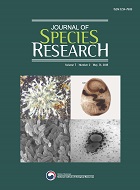- Apply for Authority
- KOREAN
- E-ISSN2713-8615
- KCI
 E-ISSN : 2713-8615
E-ISSN : 2713-8615
A report of eight unrecorded UV-resistant bacterial species in Korea isolated in 2018
Myung Kyum Kim
Gayathri Subramani
JinWoo Lee
Soohyun Maeng
Jun Hwee Jang
Ki-Eun Lee
Eun-Young Lee
Srinivasan Sathiyaraj
- Downloaded
- Viewed
Abstract
Eight bacterial strains, 18JY8-13, 18JY13-16, 18JY43-7, 18JY12-7, 18JY1-1, 18JY1-7, 18JY15-3, and 18JY7-2 assigned to the phylum Firmicutes were isolated from a variety of soil samples collected in the Jeju Island, Korea. Cells of the eight strains were Gram-positive, aerobic and showed resistant to UV-radiation. Phylogenetic analysis based on 16S rRNA gene sequence revealed that strains 18JY8-13, 18JY13-16, 18JY43-7, 18JY12-7, 18JY1-1, 18JY1-7, 18JY15-3, and 18JY7-2 were most closely related to Bacillus paranthracis (99.9%), Bacillus paramycoides (99.6%), Bacillus australimaris (99.9%), Bacillus wiedmannii (100%), Bacillus halosaccharovorans (99.6%), Bacillus deserti (98.7%), Bacillus cereus (99.8%), and Bacillus albus (100%), respectively. This is the first report of these eight species in Korea.
- keywords
- 16S rRNA, bacterial diversity, unreported species, Firmicutes, Bacillus
Reference
Demharter, W. and R. Hensel. 1989. Bacillus thermocloaceae sp. nov, a new thermophilic species from sewage-sludge. Systemic Applied Microbiology 11:272-276.
Doetsch, R. 1981. Determinative methods of light microscopy. Manual of Methods for General Bacteriology, pp. 21-33.
Edgar, R.C. 2004. MUSCLE: multiple sequence alignment with high accuracy and high throughput. Nucleic Acids Research 32:1792-1797.
Felsenstein, J. 1985. Confidence limits on phylogenies: an approach using the bootstrap. Evolution 39(4):783-791.
Hall, T.A. BioEdit: a user-friendly biological sequence alignment editor and analysis program for Windows 95/98/NT. In: Nucleic acids symposium series, 1999. vol 41. [London]: Information Retrieval Ltd., c1979-c2000, pp 95-98.
Im, S., D. Song, M. Joe, D. Kim, D.H. Park and S. Lim. 2013 Comparative survival analysis of 12 histidine kinase mutants of Deinococcus radiodurans after exposure to DNA-damaging agents. Bioprocess and Biosystems Engineering 36:781-789.
Kampfer, P., N. Lodders, B. Huber, E. Falsen and H.J. Busse. 2008. Deinococcus aquatilis sp. nov., isolated from water. International Journal of Systematic and Evolutionary Microbiology 58:2803-2806.
Kim, O.-S., Y.-J. Cho, K. Lee, S.-H. Yoon, M. Kim, H. Na, S.-C. Park, Y.S. Jeon, J.-H. Lee, H. Yi, S. Won and J. Chun. 2012. Introducing EzTaxon-e: a prokaryotic 16S rRNA gene sequence database with phylotypes that represent uncultured species. International Journal of Systematic Evolutinary Microbiology 62:716-721.
Kimura, M. 1983. The neutral theory of molecular evolution. Cambridge University Press.
Ludwig, W., K.H. Schleifer and W.B. Whitman. 2009. Revised road map to the phylum Firmicutes. In: P. De Vos, G.M. Garrity, D. Jones, N.R. Krieg, W. Ludwig, F.A. Rainey, K.-H. Schleifer and W.B. Whitman (eds.), Bergey's Manual of Systematic Bacteriology (2nd ed.), Springer, New York. vol. 3: pp. 1-14.
Roberts, M.S., L.K. Nakamura and F.M. Cohan. 1994. Bacillus mojavensis sp. nov., distinguishable from Bacillus subtilis by sexual isolation, divergence in DNA sequence, and differences in fatty acid composition. International Journal of Systematic Bacteriology 44:256-264.
Saitou, N. and M. Nei. 1987. The neighbor-joining method: a new method for reconstructing phylogenetic trees. Molecular Biology and Evolution 4:406-425.
Selvam, K., J.R. Duncan, M. Tanaka and J.R. Battista. 2013. DdrA, DdrD, and PprA: components of UV and mitomycin C resistance in Deinococcus radiodurans R1. PLoS One 8(7):e69007.
Seong, C.N., J.W. Kang, J.H. Lee, S.Y. Seo, J.J. Woo, C. Park, K.S. Bae and M.S. Kim. 2018. Taxonomic hierarchy of the phylum Firmicutes and novel Firmicutes species originated from various environments in Korea. Journal of Microbiology 56(1):1-10.
Smibert, R.M. and N.R. Krieg. 1994. Phenotypic characterization. In: P. Gerhardt, R.G.E. Murray, W.A. Wood and N.R. Krieg (eds.), Methods for General and Molecular Bacteriology, American Society for Microbiology, Washington, DC. pp. 607-654.
Tamura, K., D. Peterson, N. Peterson, G. Stecher, M. Nei and S. Kumar. 2011. MEGA5: molecular evolutionary genetics analysis using maximum likelihood, evolutionary distance, and maximum parsimony methods. Molecular Biology and Evolution 28:2731-2739.
Ruger, H.J., D. Fritze and C. Sproer. 2000. New psychrophilic and psychrotolerant Bacillus marinus strains from tropical and polar deep-sea sediments and emended description of the species. International Journal of Systematic and Evolutionary Microbiology 50:1305-1313.
Weisburg, W.G., S.M. Barns, D.A. Pelletier and D.J. Lane. 1991. 16S ribosomal DNA amplification for phylogenetic study. Journal of Bacteriology 173:697-703.
Wragg, P., L. Randall and A. Whatmore. 2014. Comparison of Biolog GEN III MicroStation semi-automated bacterial identification system with matrix-assisted laser desorption ionization-time of flight mass spectrometry and 16S ribosomal RNA gene sequencing for the identification of bacteria of veterinary interest. Journal of Microbiological Methods 105:16-21.
- Downloaded
- Viewed
- 0KCI Citations
- 0WOS Citations

